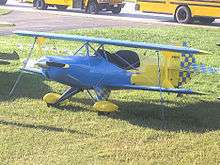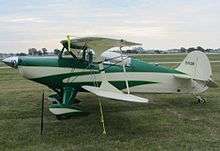Steen Skybolt
| Steen Skybolt | |
|---|---|
.jpg) | |
| Role | Aerobatic biplane |
| National origin | United States |
| Manufacturer | Steen Aero Lab Inc |
| Designer | Lamar Steen |
| First flight | October 1970 |
| Status | Plans available |
| Primary user | private owner pilots |
| Number built | over 400 |
| Variants | Starfire Firebolt |
The Steen Skybolt is an American homebuilt aerobatic biplane. Designed by teacher Lamar Steen as a high school engineering project, the prototype first flew in October 1970.[1][2]

Design and development
The aircraft has a classic structure consisting of a welded tube fuselage and wooden wings, all fabric covered. It is a tandem open-cockpit two-seat biplane and is stressed for normal aerobatics. The cockpits are frequently constructed as a single tandem cabin with an enclosing bubble canopy. Some aerobatic competition aircraft are built as single seaters with the front cockpit closed off.

The original Skybolt had a 180 hp (134 kW) Lycoming HO-360-B1B engine, but powerplants of 150 to 260 hp (112 to 194 kW) can be installed.[3]
Operational history
The Skybolt has become popular as an amateur-built sporting biplane, with over 400 aircraft having been completed from construction plans sold in over 29 countries.[3] A Skybolt won the Reserve Grand Champion Custom Built for 1979 at the Experimental Aircraft Association airshow in Oshkosh Wisconsin.[4] Sixteen examples were registered in the United Kingdom in January 2009.[5]
Variants

- Skybolt (S)
- The standard Skybolt as originally released for home-building[1][6]
- Skybolt (D)
- A revised structure and capability to have engines from 180 to 350 hp (134 to 261 kW) fitted.[6]
- Skybolt (R)
- A radial engined derivative, with revised fusellage plus the improved structure of the (D), fitted with either a 360 hp (268 kW) Vedeneyev M14P or a 400 hp (298 kW) Vedeneyev M14PF nine-cylinder radial.[6]
- Skybolt 300
- A derivative of the Skybolt fitted with a 300 hp (224 kW) engine.[6]
- Super Skybolt
- A two seater version created by John Shipler by amalgamating a Pitts S-2 with a Skybolt, the prototype of which is named Storm Warning.[6]
- Starfire Firebolt
- A development of the Skybolt with a 300 hp (224 kW) Lycoming IO-540 powerplant that gives a cruise speed of 202 mph (325 km/h) and an initial climb rate of 4,000 ft/min (20 m/s).[7][8]
Specifications (Skybolt (D))
Data from Simpson 2001
General characteristics
- Crew: one
- Capacity: one passenger
- Length: 19 ft 0 in (5.79 m)
- Wingspan: 24 ft 0 in (7.32 m)
- Height: 7 ft 0 in (2.13 m)
- Empty weight: 1,080 lb (490 kg)
- Max takeoff weight: 1,650 lb (748 kg)
- Powerplant: 1 × Lycoming HO-360-B1B piston, 180 hp (130 kW)
Performance
- Maximum speed: 145 mph (233 km/h; 126 kn)
- Cruise speed: 130 mph (209 km/h; 113 kn)
- Range: 450 mi (391 nmi; 724 km)
- Rate of climb: 2,500 ft/min (13 m/s)
See also
- Aircraft of comparable role, configuration and era
- Acro Sport II
- Pitts Special
- Sorrell Hiperbipe
- Aviat Eagle II (Christen Eagle)
Notes
- 1 2 Bayerl, Robby; Martin Berkemeier; et al: World Directory of Leisure Aviation 2011-12, page 121. WDLA UK, Lancaster UK, 2011. ISSN 1368-485X
- ↑ Tacke, Willi; Marino Boric; et al: World Directory of Light Aviation 2015-16, page 128. Flying Pages Europe SARL, 2015. ISSN 1368-485X
- 1 2 Simpson, 2001 p.521
- ↑ Sport Aviation, Oct 1979, page 71
- ↑ Pither, 2009, p.650
- 1 2 3 4 5 Whaley, Mike. "Steen Aero Lab". USA. Retrieved 25 August 2011.
- ↑ Purdy, Don: AeroCrafter - Homebuilt Aircraft Sourcebook, Fifth Edition, page 257. BAI Communications, 15 July 1998. ISBN 0-9636409-4-1
- ↑ "This One is for George…Firebolt N4GW is a flying tribute to friendship". Sport Aerobatics. October 2007.
References
External links
| Wikimedia Commons has media related to Steen Skybolt. |